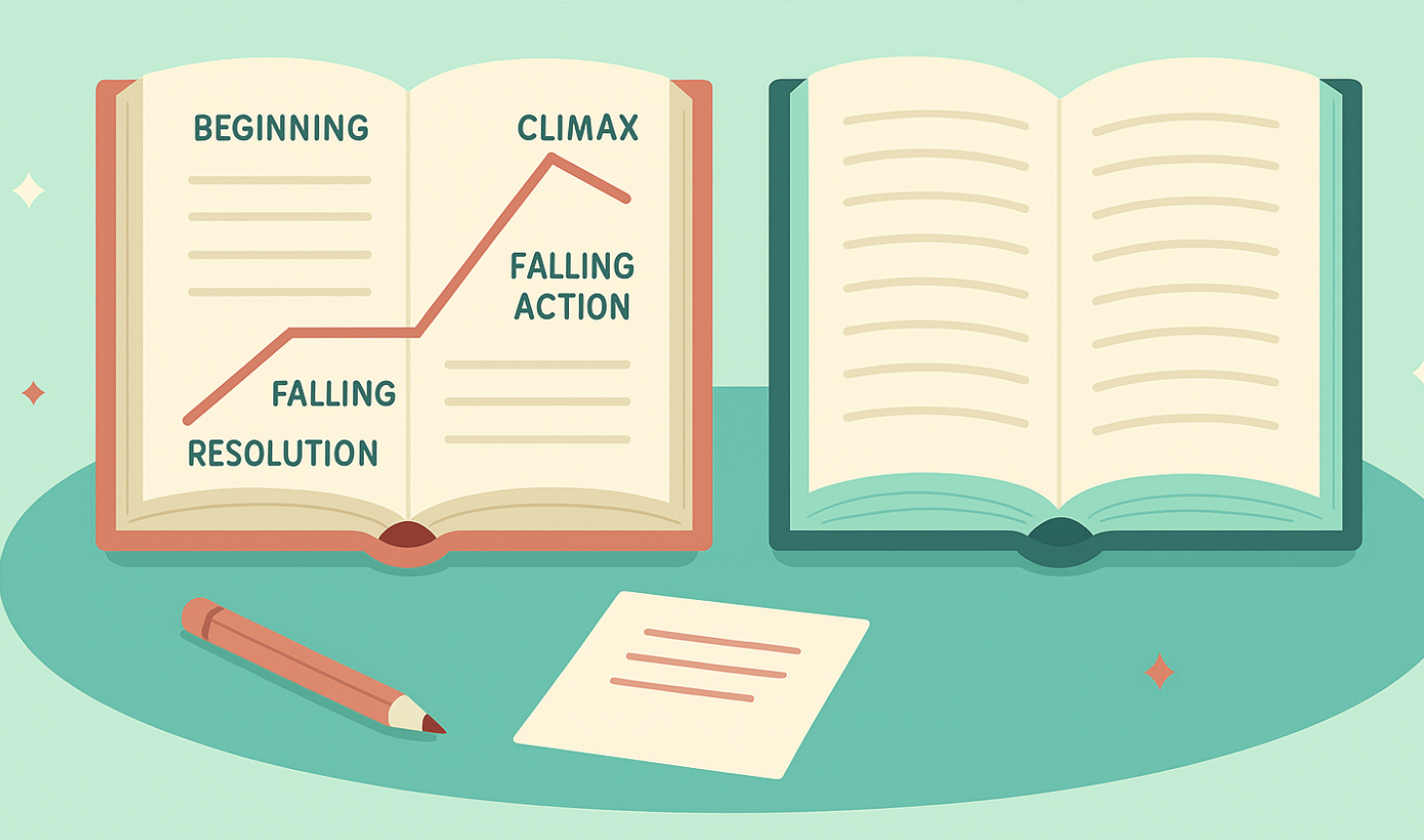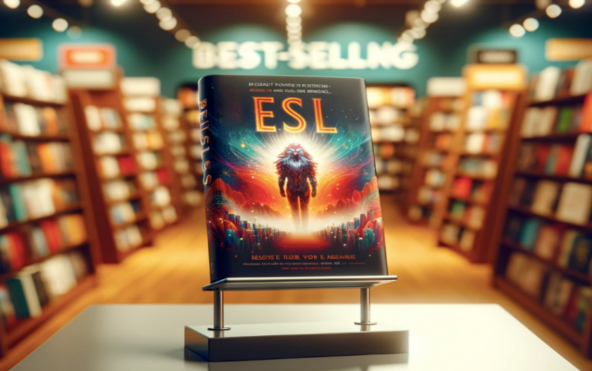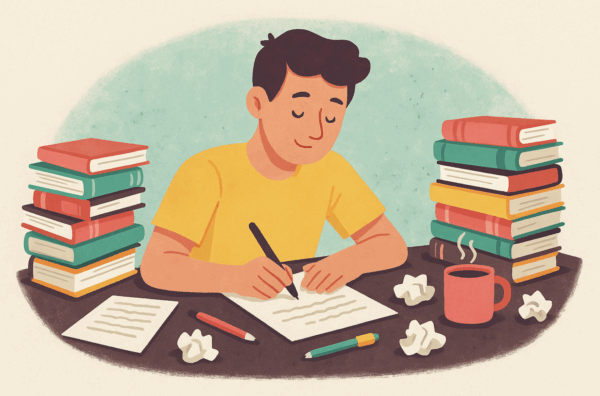Picture this: Your protagonist is cornered, outnumbered, and down to their last bullet. Just when all hope seems lost, their long-lost twin brother bursts through the door with reinforcements. Readers either cheer or roll their eyes—but they definitely keep reading.
Congratulations, you’ve just witnessed a plot device in action.
Before you start wondering “what is a plot device” exactly, here’s the truth: you’ve been using them your entire writing life. That mysterious letter that changes everything? Plot device. The mentor who dies at exactly the right moment? Another one. Even that perfectly-timed thunderstorm during your climactic scene? You guessed it.
Plot devices aren’t the literary equivalent of training wheels—they’re the gears that make your story engine purr. The trick isn’t avoiding them (spoiler alert: that’s impossible), but learning to wield them like the powerful tools they are.
Ready to discover the secret weapons hiding in plain sight throughout your manuscript? Let’s jump into the surprisingly fascinating world of plot devices and why every author should master their meaning.
What Is a Plot Device? Breaking Down the Definition Without Breaking Your Brain
Let’s start with the plot device definition that won’t make your head spin: A plot device is simply any technique a writer uses to move the story forward, create conflict, or resolve problems. Think of it as your story’s Swiss Army knife—versatile, practical, and surprisingly essential.
The term “plot device” sounds intimidatingly academic, like something only MFA graduates discuss over artisanal coffee. In reality, understanding what a plot device is can be refreshingly straightforward. It’s any narrative tool that serves your story’s needs, from the humble coincidence to the elaborate prophecy.
Here’s where plot device meaning gets interesting: the difference between brilliant and lazy isn’t the device itself—it’s the execution. A good plot device feels inevitable in hindsight, like puzzle pieces clicking into place. A lazy one screams, “the author needed something to happen here, so… magic!”
Consider these quick examples:
Brilliant: In Harry Potter, the invisibility cloak is introduced early and used consistently
Lazy: A character suddenly remembers they’re secretly a martial arts expert during the final fight
Classic: The ticking bomb creates urgency (hello, every action movie ever)
The goal isn’t to avoid plot devices—it’s to use them so skillfully that readers forget they’re even there.
Your Publishing Journey Awaits – Start NowThe Plot Device Hall of Fame: Examples That Actually Work
The Classics That Never Get Old
Some plot device examples have been around since ancient Greece, and they’re still kicking for good reason. The deus ex machina—literally “god from the machine”—swoops in to save the day when all seems lost. While purists scoff, audiences secretly love it when done right (think Eagles rescuing Frodo). Red herrings keep readers guessing by pointing them toward the wrong suspect, making the real reveal that much sweeter. And the MacGuffin? That mysterious object everyone wants but ultimately doesn’t matter—like the briefcase in Pulp Fiction. These classics work because they tap into fundamental storytelling needs: rescue, misdirection, and motivation. Sure, they’re predictable if handled clumsily, but in skilled hands, they’re storytelling gold that never tarnishes.
Modern Favorites Your Readers Secretly Love
Today’s plot device favorites reflect our complicated relationship with truth and reality. Unreliable narrators like those in Gone Girl or The Girl on the Train make readers active participants, constantly questioning what’s real. Time loops, popularized by Groundhog Day and perfected by Edge of Tomorrow, let characters (and audiences) explore cause and effect in deliciously twisted ways. Then there’s plot armor—that invisible shield protecting main characters from certain death. Readers mock it while secretly appreciating that their favorite heroes survive impossible odds. These devices succeed because they acknowledge modern audiences’ sophistication while still delivering the emotional payoffs we crave.
The Overused Culprits (And How to Fix Them)
Every plot device can wear out its welcome. Love triangles have become eye-roll territory unless you subvert expectations—maybe the two rivals fall for each other instead. The chosen one trope feels tired until you flip it (The Lego Movie brilliantly reveals everyone is special). Convenient deaths that solve plot problems scream lazy writing—instead, make death complicate things further. The fix isn’t avoiding these devices but approaching them sideways. Ask yourself: what would readers expect here, and how can I deliver something better while still giving them what they actually want?
The Good, The Bad, and The Cringe-Worthy: When Plot Devices Go Wrong
The difference between a brilliant plot device and a cringe-worthy plot convenience often comes down to one word: earned. When your protagonist suddenly discovers they’re immune to the villain’s mind control, readers want to see the groundwork laid three chapters ago, not a convenient genetic lottery win.
Understanding plot device meaning includes recognizing when you’ve crossed from storytelling tool into reader betrayal territory. The warning signs are clear: Does your device solve problems it didn’t create? Does it appear exactly when needed with no prior setup? Does it make your readers mutter “oh, come on!” at their Kindle? Congratulations—you’ve crafted a plot convenience.
Here’s the fascinating paradox: readers will tolerate obvious tropes they claim to hate while rejecting “clever” twists that feel unearned. They’ll roll their eyes at the mentor’s death but accept it if it serves the character’s growth. They’ll mock the last-minute rescue but cheer when it pays off previous setup.
The line between clever and contrived? Setup and payoff. Clever feels inevitable in hindsight. Contrived feels like the author panicked.
Quick Self-Assessment Checklist:
- Did I plant seeds for this device earlier?
- Does it create new problems or just solve old ones?
- Would the story work without it?
- Am I asking readers to accept coincidence or consequence?
- Have I earned this moment through character development?
When devices enhance your story’s natural momentum rather than hijacking it, you’ve found the sweet spot between craft and convenience.
Mastering Plot Devices: From Rookie Mistakes to Pro Moves
The Setup-Payoff Rule
Every masterful plot device follows the golden rule: if you fire a gun in Act Three, show it hanging on the wall in Act One. But here’s the pro move—disguise your setup so readers notice it without noticing it. When Chekhov mentioned his famous gun, he didn’t mean readers should spend two acts staring at the wall waiting for violence. The best setups feel natural in their moment while serving the larger story. Plant your magical sword in a casual scene about the protagonist’s heritage. Introduce the character who’ll provide crucial information during a seemingly unrelated subplot. The payoff feels earned because the setup felt organic, not like a blinking neon sign screaming “THIS WILL BE IMPORTANT LATER.”
Subverting Expectations (The Right Way)
Subversion isn’t about shocking readers—it’s about delivering something better than they expected while still satisfying the deeper need that drew them to your story. Readers expect the mentor to die? Let them live but become the villain. They’re waiting for the love triangle resolution? Reveal the “rival” is actually the protagonist’s sibling. The key is understanding what your readers actually want versus what they think they want. They want surprise, but they also want satisfaction. Great subversion gives them both by zigging when they expect a zag, but still arriving at an emotionally resonant destination.
Making Old Devices Feel Fresh
The secret to refreshing tired plot devices isn’t avoiding them—it’s combining them in unexpected ways or shifting the perspective. Take the “prophecy” device and flip it: what if the prophecy is marketing propaganda created by the villain? Or blend devices: combine the “fish out of water” with “unreliable narrator” to create a protagonist who misinterprets their new world. Even the humble “love at first sight” becomes fresh when both characters independently think the other is a serial killer. Old wine, new bottles—same emotional impact, completely different flavor.
Your Plot Device Toolkit: What Every Author Should Have Ready
Every genre has its go-to plot devices, like a carpenter’s specialized tools. Romance writers swear by forced proximity and meet-cutes, while mystery authors stock up on red herrings and locked room scenarios. Fantasy demands prophecies and magical mentors, thriller writers live on ticking clocks and unreliable allies, and science fiction thrives on fish-out-of-water scenarios and technology gone wrong.
But here’s the pro tip: don’t limit yourself to genre expectations. The best stories borrow devices across boundaries—a romance with thriller pacing, a mystery with fantasy’s sense of wonder.
Choosing the right device starts with understanding your story’s core need. Need urgency? Deploy the ticking clock. Want to build tension? Try an unreliable narrator. Struggling with pacing? A well-placed revelation can work wonders.
Building your personal library means becoming a device detective. When you love a story moment, ask why it worked. Keep a running list of devices you encounter, noting both brilliant executions and spectacular failures. Study how your favorite authors handle exposition, create conflict, and resolve tension.
For inspiration, revisit classic fairy tales (device gold mines), watch genre-blending films, and read outside your comfort zone. TV shows are particularly rich sources—they’ve mastered the art of episodic devices that serve longer arcs.
Plot Devices Are Your Friends (When You Use Them Right)
Here’s what we’ve learned: plot devices aren’t literary sins—they’re storytelling essentials. The difference between genius and hack isn’t avoiding these tools, but wielding them with intention. Setup beats surprise every time, subversion works when it serves the story, and even the most tired trope can feel fresh with the right twist.
So go ahead, experiment fearlessly. Try combining devices, flipping expectations, and borrowing from unexpected genres. Your readers aren’t device police—they’re co-conspirators who want to be swept away by a great story.
Your mission: Open your current manuscript and identify three devices you’re already using. Are they earning their keep? Could they work harder or smarter?
Now, if you’ll excuse me, I need to go rewatch Casablanca—because even Bogart couldn’t escape the power of a well-timed MacGuffin and a perfectly executed sacrifice. Plot devices: they’re everywhere, and we wouldn’t have it any other way.
Remember: devices are tools, not crutches. The best toolkit in the world can’t fix a story that lacks heart, but it can help a great story shine.
FAQs – Plot Device
Q1: Is dialogue a plot device?
Dialogue itself isn’t a plot device—it’s a narrative technique. However, specific types of dialogue can function as plot devices. Exposition-heavy conversations that conveniently reveal backstory, overheard conversations that advance the plot, or dramatic confrontations that force character revelations are all examples of dialogue serving as plot devices. The key difference: regular dialogue develops character and feels natural, while dialogue-as-plot-device primarily serves the story’s mechanical needs.
Q2: What are the 4 types of plot?
The four classic plot types are: Man vs. Man (character against character), Man vs. Nature (character against natural forces), Man vs. Society (character against social systems), and Man vs. Self (internal conflict). Some modern frameworks add Man vs. Technology and Man vs. Supernatural. Each type creates different storytelling opportunities and typically employs specific plot devices—love triangles for interpersonal conflict, ticking clocks for nature/disaster stories, and chosen one tropes for society conflicts.
Q3: What is it called when everyone wants the plot device?
That’s called a MacGuffin—an object, person, or goal that multiple characters desperately want, but whose specific nature matters less than the chase it creates. Think the One Ring, the Death Star plans, or the briefcase in Pulp Fiction. The MacGuffin drives the plot forward by giving everyone something to fight over, but often becomes irrelevant once the story reaches its emotional climax.
Q4: How do you avoid plot devices?
Here’s the truth: you can’t and shouldn’t avoid plot devices entirely—they’re fundamental storytelling tools. Instead, focus on using them well. Avoid lazy plot devices by ensuring proper setup and payoff, making consequences feel earned rather than convenient, and choosing devices that enhance rather than replace character development. The goal isn’t elimination but elevation—turn obvious devices into seamless story elements.
Q5: Is suspense a plot device?
Suspense is more accurately described as an emotional effect created by various plot devices rather than a device itself. However, specific techniques that create suspense—like the ticking clock, dramatic irony (when readers know something characters don’t), or withholding crucial information—are definitely plot devices. Think of suspense as the goal and plot devices as the tools to achieve it. A bomb under the table creates suspense, but the bomb itself is the plot device.
Q6: How do you make a good plot device?
Create good plot devices by following three rules:
- Set up early (plant seeds before you need the payoff),
- Serve character development (devices should reveal or challenge your characters),
- Make it feel inevitable in hindsight (readers should think “of course!” not “where did that come from?”).
The best plot devices solve one problem while creating new ones, keeping your story’s momentum alive. Remember: a good device enhances your story’s natural flow rather than forcing it in artificial directions.







